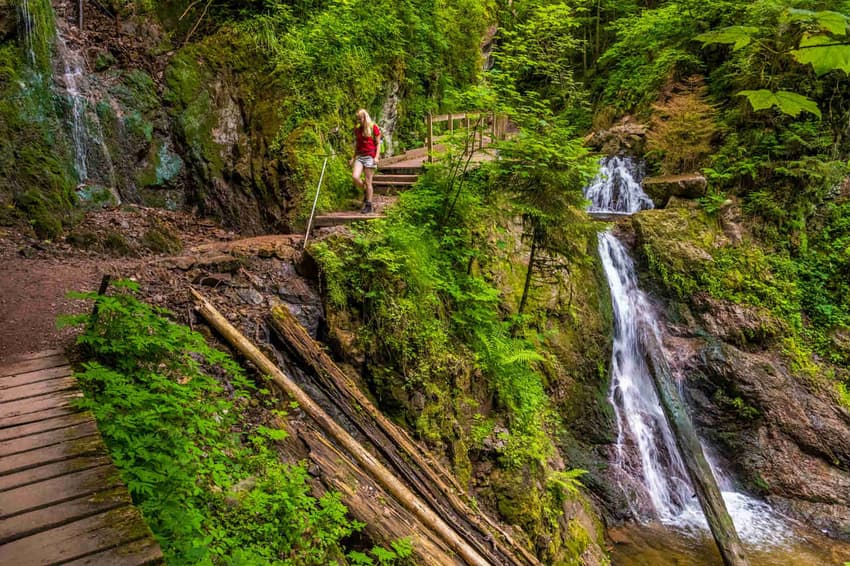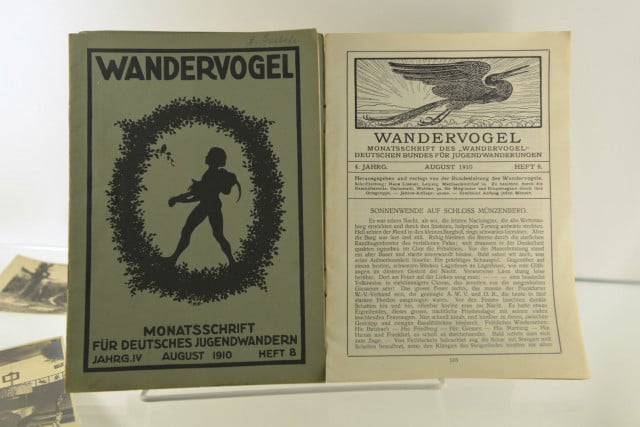Wandervogel: How to get back to nature and embrace the wilderness like the Germans

Ancient forests, romantic meadows, crystal-clear lakes – Germany is graced with many natural wonders. So, it’s no surprise that strolling through nature is as German as grilling sausages.
The country’s rich vocabulary of traveling and journeying has seeped into the English language. Aching to visit faraway places? You have been afflicted with what the Germans diagnose as Fernweh. Have an irresistible urge to explore the world? You must have Wanderlust.
But there is another word that can help us tap into the German psyche and learn more about Germany’s deep connection to nature, and that is Wandervogel. Translated literally as “wandering bird,” it is both a feeling and a historical movement.
In the spirit of Wandervogel, wayfaring Germans strap on their hiking boots, pack their thermoses in their trusty backpacks and lose themselves in their country’s network of mountains, gorges, and rivers. Like birds migrating in the spring, they soar from one destination to the next during their weekend backpacking trip or month-long adventure.
Even Germans who frown at the vagabond lifestyle delight in an afternoon of aimless Spazierengehen or Lustwandeln (strolling or wandering at leisure), followed by Kuchen and Kaffee in a cozy café.
Germans’ connection to nature also helps to the explain the creation of green oases in urban neighbourhoods and the national commitment to take care of the planet. More than 90 percent of Germans associate nature in the city to recovery, quality of life, and health and attach importance to public parks and urban forests, according to a study by the Federal Ministry for the Environment and Agency for Nature Conservation.
Moreover, the country’s idyllic landscape – inspiring countless storytellers, poets, and painters – has taken on a mythical status. The subject in Caspar David Friedrich’s Romantic painting Wanderer above the Sea of Fog (1818) stands at the edge of a cliff, wonderstruck, as he gazes into the mist-filled sky and mountains below, experiencing both mastery over his surroundings and awe at its breadth and beauty.
Likewise, the Grimm Brothers’ treasure chest of fairy tales, where menacing wolves prey on girls in red-riding hoods and sweet-toothed siblings get lost in the dark woods, has fueled Germany’s fascination with forests.
Historical movement

Monthly journal of the Wandervogel from 1910. Photo: DPA
The Wandervogel is not only a cultural phenomenon, but also a part of German history that finds its origins in a youth from Steglitz (modern day Berlin) in 1896. The children of bourgeois parents became disillusioned with industrialization. They scorned the onset of materialist, consumerist society and yearned for the pre-industrial days where people lived off the land, sang folk songs, and embraced nature.
These wandering fledglings broke away from the constraints of their social environment and banded together in youth groups, pioneering a Jugendkultur, a culture of youths led by youths. The movement spread quickly across the country.
Trekking through mountainous trails in hiking shorts, strumming their guitars by the campfire, and sleeping under the stars, they sought to become at one with nature and create a better, emancipated future for themselves.
At the outbreak of war in 1914, millions of young men swept up in a wave of patriotic enthusiasm marched to their deaths. The once apolitical youth movement subsequently splintered into rival groups, many with a strong ideological bent, including the Young Socialists, Young Democrats, and Young Conservatives.
The defeated Germany plunged into further economic chaos with the Great Crash of 1929. Young people suffered disproportionately. What had once been a lifestyle choice had become a matter of grim necessity. Half a million adolescents, homeless and unemployed, tramped around the country committing petty crimes.
When the Nazis came to power in 1933, they dissolved the Wandervogel along with other youth organizations and established the more militarized and politicized Hitler Youth to replace them all.
While many Wandervogel groups rejected Nazi authoritarianism and some even evolved into counter movements like the Edelweiss Pirates, historian Walter Laqueur – who wrote a formative work on the youth group – argues that they promoted a völkisch vision of Germany that, among other factors, contributed to the rise of the Nazis.
Indeed the Hitler Youth copied many Wandervogel traditions, such as the uniforms, straight-arm salutes, and greeting “heil.”
Following the Second World War, the Wandervogel was re-established as an apolitical youth group, committed to the original ethos of freedom, exploration, and reverence for natural beauty. The movement has several thousand members today, but endures most profoundly in the German attitude towards nature.
While the sun is still shining, awaken your ancient instincts and venture into the wilderness like the Germans. The majestic Black Forest awaits you.
Comments
See Also
The country’s rich vocabulary of traveling and journeying has seeped into the English language. Aching to visit faraway places? You have been afflicted with what the Germans diagnose as Fernweh. Have an irresistible urge to explore the world? You must have Wanderlust.
But there is another word that can help us tap into the German psyche and learn more about Germany’s deep connection to nature, and that is Wandervogel. Translated literally as “wandering bird,” it is both a feeling and a historical movement.
In the spirit of Wandervogel, wayfaring Germans strap on their hiking boots, pack their thermoses in their trusty backpacks and lose themselves in their country’s network of mountains, gorges, and rivers. Like birds migrating in the spring, they soar from one destination to the next during their weekend backpacking trip or month-long adventure.
Even Germans who frown at the vagabond lifestyle delight in an afternoon of aimless Spazierengehen or Lustwandeln (strolling or wandering at leisure), followed by Kuchen and Kaffee in a cozy café.
Germans’ connection to nature also helps to the explain the creation of green oases in urban neighbourhoods and the national commitment to take care of the planet. More than 90 percent of Germans associate nature in the city to recovery, quality of life, and health and attach importance to public parks and urban forests, according to a study by the Federal Ministry for the Environment and Agency for Nature Conservation.
Moreover, the country’s idyllic landscape – inspiring countless storytellers, poets, and painters – has taken on a mythical status. The subject in Caspar David Friedrich’s Romantic painting Wanderer above the Sea of Fog (1818) stands at the edge of a cliff, wonderstruck, as he gazes into the mist-filled sky and mountains below, experiencing both mastery over his surroundings and awe at its breadth and beauty.
Likewise, the Grimm Brothers’ treasure chest of fairy tales, where menacing wolves prey on girls in red-riding hoods and sweet-toothed siblings get lost in the dark woods, has fueled Germany’s fascination with forests.
Historical movement

Monthly journal of the Wandervogel from 1910. Photo: DPA
The Wandervogel is not only a cultural phenomenon, but also a part of German history that finds its origins in a youth from Steglitz (modern day Berlin) in 1896. The children of bourgeois parents became disillusioned with industrialization. They scorned the onset of materialist, consumerist society and yearned for the pre-industrial days where people lived off the land, sang folk songs, and embraced nature.
These wandering fledglings broke away from the constraints of their social environment and banded together in youth groups, pioneering a Jugendkultur, a culture of youths led by youths. The movement spread quickly across the country.
Trekking through mountainous trails in hiking shorts, strumming their guitars by the campfire, and sleeping under the stars, they sought to become at one with nature and create a better, emancipated future for themselves.
At the outbreak of war in 1914, millions of young men swept up in a wave of patriotic enthusiasm marched to their deaths. The once apolitical youth movement subsequently splintered into rival groups, many with a strong ideological bent, including the Young Socialists, Young Democrats, and Young Conservatives.
The defeated Germany plunged into further economic chaos with the Great Crash of 1929. Young people suffered disproportionately. What had once been a lifestyle choice had become a matter of grim necessity. Half a million adolescents, homeless and unemployed, tramped around the country committing petty crimes.
When the Nazis came to power in 1933, they dissolved the Wandervogel along with other youth organizations and established the more militarized and politicized Hitler Youth to replace them all.
While many Wandervogel groups rejected Nazi authoritarianism and some even evolved into counter movements like the Edelweiss Pirates, historian Walter Laqueur – who wrote a formative work on the youth group – argues that they promoted a völkisch vision of Germany that, among other factors, contributed to the rise of the Nazis.
Indeed the Hitler Youth copied many Wandervogel traditions, such as the uniforms, straight-arm salutes, and greeting “heil.”
Following the Second World War, the Wandervogel was re-established as an apolitical youth group, committed to the original ethos of freedom, exploration, and reverence for natural beauty. The movement has several thousand members today, but endures most profoundly in the German attitude towards nature.
While the sun is still shining, awaken your ancient instincts and venture into the wilderness like the Germans. The majestic Black Forest awaits you.
Join the conversation in our comments section below. Share your own views and experience and if you have a question or suggestion for our journalists then email us at [email protected].
Please keep comments civil, constructive and on topic – and make sure to read our terms of use before getting involved.
Please log in here to leave a comment.